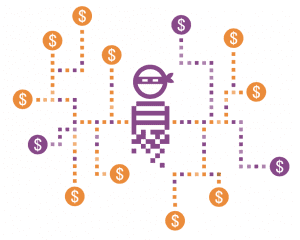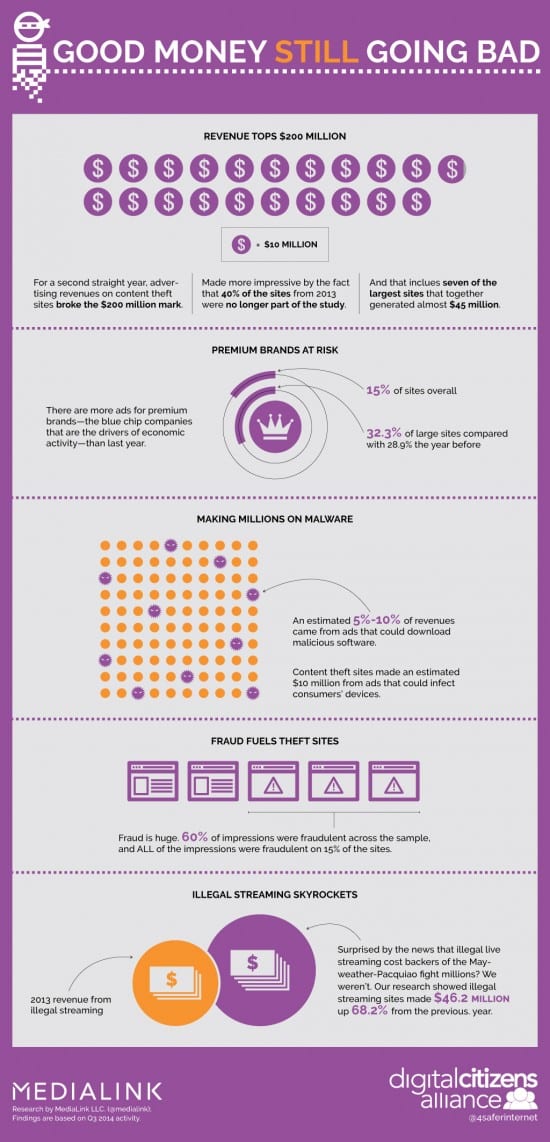Why Advertising Still Has a Piracy Problem
 Earlier this month the Digital Citizens Alliance released a new report on advertising on piracy websites entitled “Good Money Still Going Bad”.
Earlier this month the Digital Citizens Alliance released a new report on advertising on piracy websites entitled “Good Money Still Going Bad”.
A follow up to its 2014 report “Good Money Going Bad” (Previous Coverage), which looked at the year 2013, the new report mimics the same approach, but for the new year. In both reports they started by locating sites that had received more than 25 DMCA takedown notices with Google in the third quarter of the year and then removed sites that were ineligible for the study, including porn sites, user-generated content sites and sites that didn’t target movies or TV shows.
That left them with 589 qualifying sites, compared to 596 sites in the previous report. From there, they analyzed the advertising on the sites, noting what ads were appearing, what networks they were using and what the estimated revenue was. They continued to look at the third quarter and extrapolated from there the rest of the year.
The report largely shows a landscape unchanged. Though 40% of the sites in the original report are no longer active, other sites had flooded in and the total amount of revenue earned by the sites was largely unchanged, $209 million in 2014 compared to $227 million in 2013, a drop of approximately 8%.
Though the total revenue dropped slightly more “premium” brands were observed on piracy-oriented sites, up to 132 in 2014 from 89 in 2013 and the report also noted a marked increase in video streaming, which was up 40% from the previous report.
So why is it that, after years of attention on this issue, so little improvement has been made? The reasons are complicated but a lot of the issue has less to do with piracy and more to do with the way online advertising works.
The Black Box Problem
The big problem with fight advertising on copyright infringing (or other unwanted) content is that online advertising is a metaphorical black box. Most know what goes into the box and everyone knows come out the other side, but what happens in between is often a mystery.
A big brand, like Sprint or Budget, both of which are cited in the report, likely handle their digital advertising through an ad agency, either a digital agency or a larger one that handles traditional and digital advertising. That agency then designs ads and prepares campaigns, that are approved by the brand.
The agency may plan specific buys on specific sites, but a lot of the ad purchases are likely handled by an ad buying firm, with the goal of placing it on placing it in front of as many people in the target demographic as possible. Those buyers then work with ad networks, who likely work with smaller networks that then work with the sites directly.
In short, there is likely between half a dozen to a dozen layers between the brand and the site the ads appear on and there’s almost no accountability. Advertising companies pop in and out of business all of the time as do pirate websites. Spotting pirate sites, determining who is responsible for keeping them out of the advertising pool and enforcing those rules is nearly impossible.
The issue isn’t helped by the fact that the advertising industry is incredibly spread out. As the latest report shows, Google-owned DoubleClick was the far away leader among ad networks in number of piracy-oriented sites it was on with 109. However, that’s still less than 20% of all sites in the report.
Even if DoubleClick were to shutter all copyright infringing accounts tomorrow, there would still be dozens of ad networks ready and able to pick up the slack, with almost no hope for accountability. Furthermore, most sites likely use multiple networks, meaning it wouldn’t even completely remove all of the advertising from those 109 sites.
The truth is though, when piracy sites get into the mainstream ad marketplace, it’s usually not the work of the big players, but smaller companies at the bottom of the advertising food chain reselling space to bigger players.
This, in turn, makes it very difficult to solve the problem of ad-supported piracy.
Fixing the Problem
Fixing this issue isn’t going to be easy. Putting pressure on brands is an important step, but it can’t fix the problem unless they have actual control over where their ads appear.
While tracking an ad from creation to appearance is possible, it requires cooperation from every person in the advertising chain and many of the players have no reason or ability to cooperate.
This really limits brands in what they can do to limit this problem:
- Buy on a Per-Site Basis: Limit their buys only to specific sites and completely micromanage the ad-buying process.
- Draft Strict Contracts: Draft strict contracts barring the appearance of ads on pirate and other unwanted sites, holding their immediate suppliers accountable.
The second option, most likely, isn’t practical. Any large ad buyer knows the difficulty in keeping their ad buys 100% free from unwanted content and would be unlikely to agree to such terms. However, the first option isn’t much more practical though as such micromanagent would greatly increase the cost and complexity of such a campaign, leading to much fewer people reached just to avoid a comparatively small number of pirate sites.
In short it’s going to take a lot of pressure on advertisers, particularly financial pressure, to force them to push for the changes needed in the advertising industry to prevent this from happening.
While it’s certainly possible, we clearly haven’t reached that point yet.
Bottom Line
To be clear, legitimate ads appearing on pirate sites is not the intent. Unfortunate ad placement is extremely common in online advertising and piracy is just one of the problems.
That being said, even if all major brands were able to successfully prevent their ads from appearing on pirate sites, it wouldn’t be the end of such sites or of advertising on them. Visit any pirate site and most of the ads you’ll find are already for non-mainstream products and services, the types of things more commonly seen in email spam than store shelves.
However, those ads pay significantly less than mainstream advertisers and actually hurt the impact of such sites. After all, a pirate site that carries ads for major brands looks far more legitimate than one selling questionable dating sites and pharmaceuticals.
So while the path to stopping ad-supported piracy is important, it will not be easy and it’s going to require a complete overhaul of the online advertising industry. That kind of change only comes at the tip of severe financial pressure.
Otherwise, we can nip at the edge of the problem, but not really address the core issue. That’s because, as long as online advertising is a black box, sometimes the ads are going to come out in the wrong places and there’s little that can be done about it.
Inforgraphic
Want to Reuse or Republish this Content?
If you want to feature this article in your site, classroom or elsewhere, just let us know! We usually grant permission within 24 hours.

